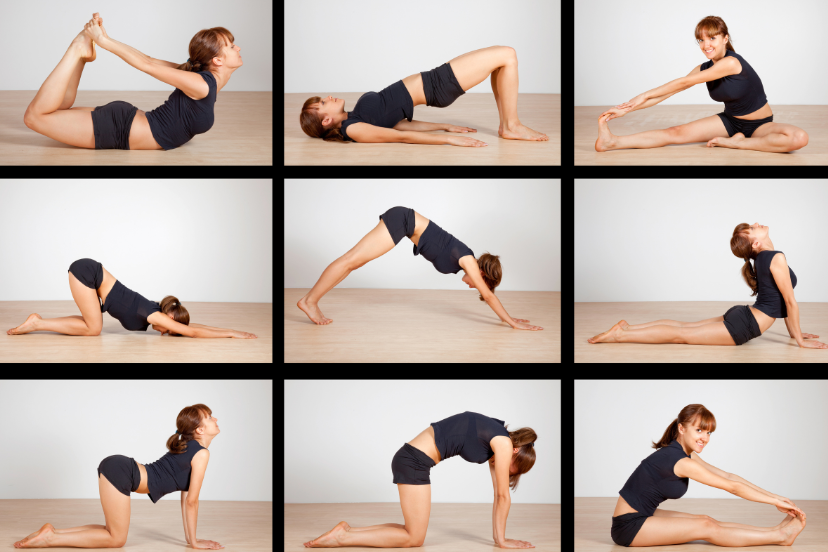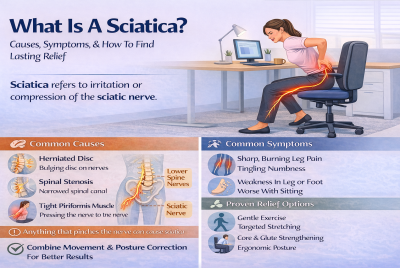Yoga For Sciatica
Discover the power of yoga for sciatica relief! Explore effective poses and tips in our comprehensive guide. Dive in and find relief today! Sciatica, a condition characterized by pain radiating along the sciatic nerve, affects millions of people worldwide. Having personally battled with sciatica, I understand the immense physical and emotional toll it can take. In this comprehensive guide, I will delve deeper into the world of yoga for sciatica, providing valuable insights, tips, and a range of yoga poses to help you manage and find relief from this often debilitating condition.
Introduction To Sciatica And Its Causes
Sciatica is a term used to describe the pain, tingling, or numbness that occurs when the sciatic nerve, which runs from the lower back down through the buttocks and into the legs, becomes irritated or compressed. This nerve is the largest in the body and plays a crucial role in connecting the spinal cord to the leg and foot muscles.
Common Causes Of Sciatica
Sciatica can result from various underlying conditions, including:
- Herniated Disc: When the gel-like center of a spinal disc protrudes through a tear in the outer layer, it can press on the sciatic nerve.
- Spinal Stenosis: This condition involves the narrowing of the spinal canal, which can put pressure on the nerves, including the sciatic nerve.
- Piriformis Syndrome: The piriformis muscle, located deep within the buttocks, can irritate or compress the sciatic nerve when it tightens or spasms.
- Degenerative Disc Disease: As we age, the discs in our spine can naturally degenerate, potentially leading to sciatica.
- Spondylolisthesis: This condition occurs when one vertebra slips forward over another, causing nerve compression.
- Trauma Or Injury: Any injury to the lower back or pelvis can affect the sciatic nerve.
Understanding The Role Of Yoga In Managing Sciatica
Yoga actively aids in managing sciatica by reducing pain, improving flexibility, and strengthening core muscles.
The Benefits Of Yoga For Sciatica
Yoga, a practice that combines physical postures, breathing exercises, and mindfulness, offers a holistic approach to managing sciatica. Here are some of the key benefits it brings:
Pain Management
Yoga can help reduce the intensity and frequency of sciatic pain by stretching and strengthening the muscles surrounding the sciatic nerve. Additionally, yoga promotes the release of endorphins, which are natural pain relievers.
Improved Flexibility
Many yoga poses focus on gentle stretching, which can alleviate pressure on the sciatic nerve by increasing flexibility in the lower back, hips, and legs.
Strengthening The Core
A strong core provides better support to the spine, reducing the risk of aggravating sciatica. Yoga emphasizes core engagement and stability.
Stress Reduction
Chronic pain conditions like sciatica often lead to increased stress and tension. Yoga’s relaxation techniques, including deep breathing and meditation, can lower stress levels and improve overall well-being.
Enhanced Posture
Correct posture is crucial for individuals with sciatica. Yoga encourages body awareness and alignment, helping you maintain good posture in your daily life.
The Importance Of Correct Posture
Before we dive into specific yoga poses, it’s essential to emphasize the significance of maintaining proper posture during your practice. Correct posture ensures that you receive the full benefits of each pose while minimizing the risk of exacerbating your condition.
Best Yoga Poses For Sciatica Relief
Child’s Pose (Balasana)
How to Perform:
- Start in a kneeling position.
- Sit back onto your heels.
- Extend your arms forward, lowering your chest to the floor.
- Rest your forehead on the mat and breathe deeply.
Benefits Of Child’s Pose:
- Gently stretch the lower back.
- Relieves tension in the hips and buttocks.
- Provides immediate relief from sciatic pain.
Cat-Cow Pose (Marjaryasana-Bitilasana)
How to Perform:
- Begin on your hands and knees in a tabletop position.
- Inhale, arch your back (Cow Pose).
- Exhale, round your back (Cat Pose).
- Repeat the movement, syncing breath with movement.
Benefits Of Cat-Cow Pose:
- Promotes flexibility in the spine.
- Releases tension in the lower back.
- Enhances mobility in the pelvis.
Downward-Facing Dog (Adho Mukha Svanasana)
How to Perform:
- Start in a plank position.
- Lift your hips toward the ceiling.
- Press your heels towards the floor.
- Keep your spine long and engage your core.
Benefits Of Downward-Facing Dog:
- Stretches the hamstrings and calves.
- Strengthens the entire body, including the core.
- Promotes circulation in the lower back.
Cobra Pose (Bhujangasana)
How to Perform:
- Lie face down with your palms under your shoulders.
- Inhale, lift your chest and head off the mat.
- Keep your elbows slightly bent.
- Engage your back muscles.
Benefits Of Cobra Pose:
- Opens up the chest and shoulders.
- Relieves pressure on the sciatic nerve.
- Strengthens the lower back.
Pigeon Pose (Eka Pada Rajakapotasana)
How to Perform:
- Begin in a tabletop position.
- Bring your right knee toward your right wrist.
- Extend your left leg behind you.
- Square your hips and fold forward over your right leg.
Benefits Of Pigeon Pose:
- Deeply stretches the hip flexors and piriformis muscle.
- Relieves tension in the buttocks and lower back.
- It can alleviate sciatic pain caused by tight hips.
Bridge Pose (Setu Bandhasana)
How to Perform:
- Lie on your back with your knees bent and feet hip-width apart.
- Place your arms by your sides, palms facing down.
- Inhale, lift your hips off the floor.
- Keep your thighs and feet parallel.
Benefits Of Bridge Pose:
- Strengthens the back, glutes, and hamstrings.
- Provides essential support to the lower back.
- Encourages gentle spinal extension.
Seated Forward Bend (Paschimottanasana)
How to Perform:
- Sit with your legs extended in front of you.
- Inhale, lengthen your spine.
- Exhale, hinge at your hips to reach toward your toes.
- Hold onto your shins, ankles, or feet as comfortable.
Benefits Of Seated Forward Bend:
- Stretches the hamstrings and lower back.
- Relieves tension in the sciatic nerve.
- Encourages relaxation and mindfulness.
Thread The Needle Pose
How to Perform:
- Begin in a tabletop position.
- Slide your right arm under your left arm.
- Lower your right shoulder and ear to the mat.
- Press your left hand into the floor to deepen the stretch.
Benefits Of Thread The Needle Pose:
- Releases tension in the lower back and hips.
- Provides a gentle twist that can alleviate sciatic discomfort.
- Stretches the shoulders and upper back.
Spinal Twist (Ardha Matsyendrasana)
How to Perform:
- Sit with your legs extended.
- Bend your right knee and cross it over your left leg.
- Place your left elbow on the outside of your right knee.
- Gently twist to the right, looking over your right shoulder.
Benefits Of Spinal Twist:
- Promotes spinal flexibility and mobility.
- Relieves tension along the sciatic nerve.
- It improves digestion and detoxification.
Creating A Safe And Effective Yoga Routine
To harness the full potential of yoga for sciatica relief, it’s essential to structure your practice thoughtfully. Here are some guidelines to consider:
Warm-Up And Cool-Down
Before engaging in any yoga poses, it’s crucial to prepare your body with a proper warm-up and conclude your practice with a cool-down. A warm-up can consist of gentle movements, such as neck circles, shoulder rolls, and pelvic tilts, to increase blood flow to the muscles and joints. After your yoga session, a cool-down, including relaxation poses and deep breathing, helps your body return to a state of rest and promotes muscle recovery.
Breathing Techniques (Pranayama)
Integrating pranayama, or yogic breathing exercises, into your routine can enhance your sciatica management. Deep and controlled breathing helps relax your nervous system and reduces stress, which can exacerbate sciatic pain. A simple pranayama practice involves inhaling deeply through your nose, allowing your abdomen to expand, and exhaling slowly through your mouth. Focusing on your breath also cultivates mindfulness, allowing you to better connect with your body.
Props And Modifications
Yoga is a highly adaptable practice, and there are numerous props and modifications available to accommodate individuals with sciatica. If you experience limitations in your range of motion or comfort level, don’t hesitate to use props such as yoga blocks, straps, or cushions. These tools can provide the necessary support to ensure a safe and effective practice. Moreover, consider exploring variations of yoga poses that are gentler on your body. Yoga instructors and physical therapists can offer guidance in selecting the right modifications for your unique needs.
Personal Experiences And Tips
My Journey With Sciatica
My experience with sciatica was a challenging journey marked by pain, frustration, and uncertainty. However, yoga became my steadfast companion, guiding me towards relief and improved well-being. If you’re grappling with sciatica, it’s essential to remember that healing is not instantaneous. It’s a process that requires patience, consistency, and self-compassion.
Here are a few insights and tips I’d like to share from my own path to recovery:
- Consistency Is Key: To experience the benefits of yoga for sciatica, commit to a regular practice. Aim for at least 3-4 times a week to notice substantial improvements.
- Listen To Your Body: Sciatica varies from person to person, so pay close attention to how your body responds to different poses. If a pose causes discomfort or pain, modify it or skip it altogether.
- Professional Guidance: If you’re new to yoga or have severe sciatica, consider seeking guidance from a certified yoga instructor or physical therapist. They can help tailor a practice that suits your specific needs and limitations.
- Stay Positive: Maintaining a positive mindset and focusing on your progress can be a potent motivator on your journey to sciatica relief. Celebrate even small achievements and milestones along the way.
How Yoga Transformed My Life
Beyond the physical benefits, yoga has had a profound impact on my life. It transformed me not only physically but also mentally and emotionally. Here are some ways in which yoga can bring about positive changes:
- Mind-Body Connection: Yoga fosters a deep connection between your mind and body. As you become more attuned to your physical sensations and breath, you develop greater self-awareness and mindfulness.
- Stress Reduction: The practice of yoga encourages relaxation and stress reduction, which can be particularly beneficial for individuals with chronic pain conditions like sciatica.
- Improved Quality Of Life: Sciatica can limit your daily activities and overall quality of life. By incorporating yoga, you can regain mobility, reduce pain, and enhance your well-being.
- Empowerment: Overcoming the challenges of sciatica through yoga can be empowering. It instills a sense of resilience and self-efficacy, reminding you of your innate ability to heal and thrive.
Frequently Asked Questions (FAQs)
Is yoga a cure for sciatica?
Yoga is not a cure for sciatica but can be a valuable tool for managing its symptoms, reducing pain, and improving overall well-being.
How often should I practice yoga for sciatica relief?
Consistency is key. Aim for at least 3-4 times a week to experience noticeable improvements in your sciatica symptoms.
Are there any yoga poses I should avoid with sciatica?
Certain yoga poses, particularly deep forward bends, may aggravate sciatic pain. Consult with a certified yoga instructor or physical therapist for suitable modifications.
Can yoga replace medical treatment for sciatica?
Yoga can complement medical treatment but should not replace it. Always follow your doctor’s advice and recommendations for managing your sciatica.
What other lifestyle changes can help with sciatica?
Engaging in regular physical activity, maintaining a healthy weight, practicing proper posture, and avoiding prolonged periods of sitting can actively contribute to sciatica management. These lifestyle changes promote spinal health, reduce pressure on the sciatic nerve, and enhance overall well-being, complementing any treatment or exercise regimen.
Extra FAQs Related To Yoga For Sciatica
Is yoga good for sciatica?
Yoga is beneficial for sciatica. It reduces pain, enhances flexibility, strengthens core muscles, and promotes overall well-being. Regular practice of sciatica-focused yoga can provide effective relief and improved quality of life.
What are the best yoga stretches for sciatica?
The best yoga stretches for sciatica include poses like Child’s Pose, Cat-Cow Pose, Downward-Facing Dog, Cobra Pose, Pigeon Pose, Bridge Pose, Seated Forward Bend, Thread the Needle Pose, and Spinal Twist.
Is yoga or pilates better for sciatica?
Yoga surpasses Pilates in addressing sciatica. Yoga’s diverse poses, stretching, and mindfulness techniques actively target pain relief, flexibility, and overall well-being, making it the preferred choice for managing sciatica.
Is hot yoga good for sciatica?
Hot yoga can benefit some individuals with sciatica as the heat may help relax muscles and improve flexibility. However, practicing caution, staying hydrated, and ensuring the heat doesn’t exacerbate your condition is essential. Consult a healthcare professional or a certified yoga instructor for personalized guidance.
What are the best yoga poses for sciatica?
The best yoga poses for sciatica include those that actively stretch and strengthen the affected muscles, such as Child’s Pose, Cat-Cow Pose, Downward-Facing Dog, Cobra Pose, Pigeon Pose, Bridge Pose, and Spinal Twist.
Yoga For Sciatica – Conclusion
Incorporating yoga into your life can be a game-changer when dealing with sciatica. Its gentle yet effective approach can provide much-needed relief and improve your overall well-being. However, it’s essential to approach yoga as a complementary tool to your existing medical treatment, not a replacement. Always consult with a healthcare professional before starting any new exercise routine, especially if you have underlying medical conditions.
Remember that your journey to sciatica relief is unique, and healing takes time. Be patient with yourself, stay consistent in your practice, and let yoga be a source of healing, empowerment, and self-discovery. The path to relief may be challenging, but with the right guidance and a positive mindset, you can find the relief you seek.
Disclaimer
Please note that the information provided in this article is for informational purposes only and should not replace professional medical advice. If you’re experiencing sciatica pain or any health concerns, it’s advisable to consult a healthcare professional for proper diagnosis and treatment.
👉 Explore more:




